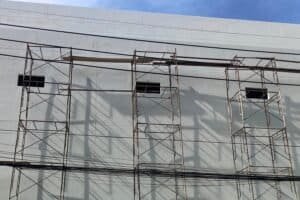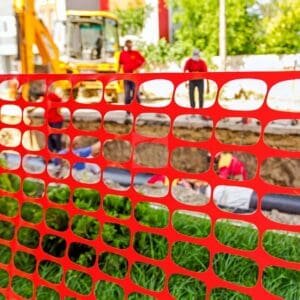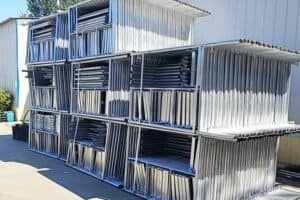Scaffolding safety is crucial for construction workers. OSHA, the safety authority, sets rules to keep workers safe when using scaffolds. OSHA’s requirements cover all types of scaffolding, including supported scaffolds with frames or poles and suspended scaffolds hanging from above. These rules are essential to follow to prevent accidents and injuries.
Requirement 1: General Requirements
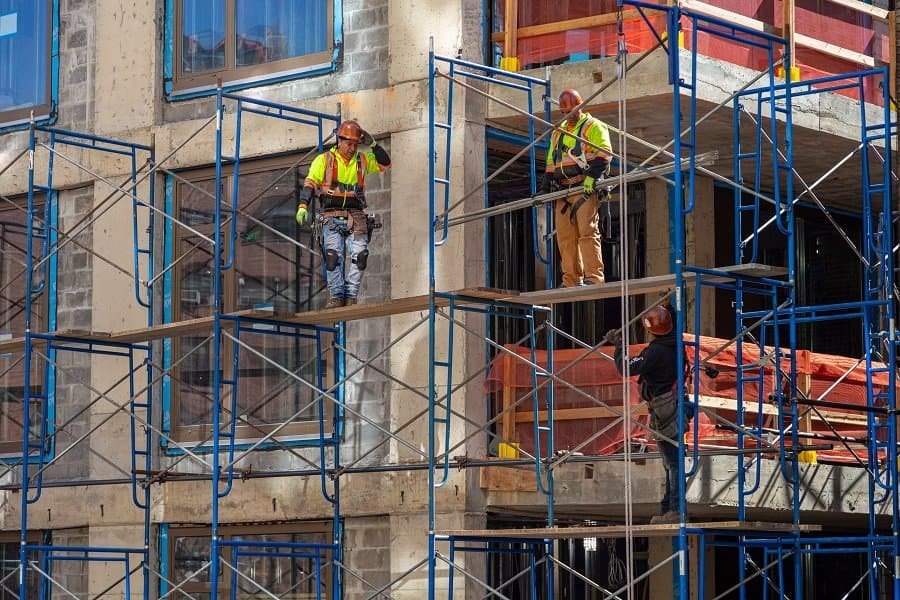
General requirements for scaffolding focus on ensuring safety and stability on construction sites. Scaffolds must be strong enough to support their weight and any loads placed on them. They need to be able to handle at least four times the maximum weight they’re expected to bear. All scaffold parts must be securely attached to prevent collapses or accidents.
Load capacity regulations are vital. Scaffolds must be designed by someone who knows what they’re doing and supervised by a competent person during setup, movement, dismantling, or changes. Again, they should handle at least four times the maximum weight they’re meant to hold.
Access to scaffold platforms must be safe. Workers need to be able to get on and off easily and securely. Ladders, stairs, or ramps must be provided if a platform is over two feet above the ground.
Guardrails and toeboards are essential safety features. Guardrails and midrails must be installed on all open sides and ends of scaffold platforms to prevent falls, and toeboards should be installed along the edges to stop objects from dropping. These measures help protect workers and keep the job site safe.
Requirement 2: Specific Requirements for Different Types of Scaffolding
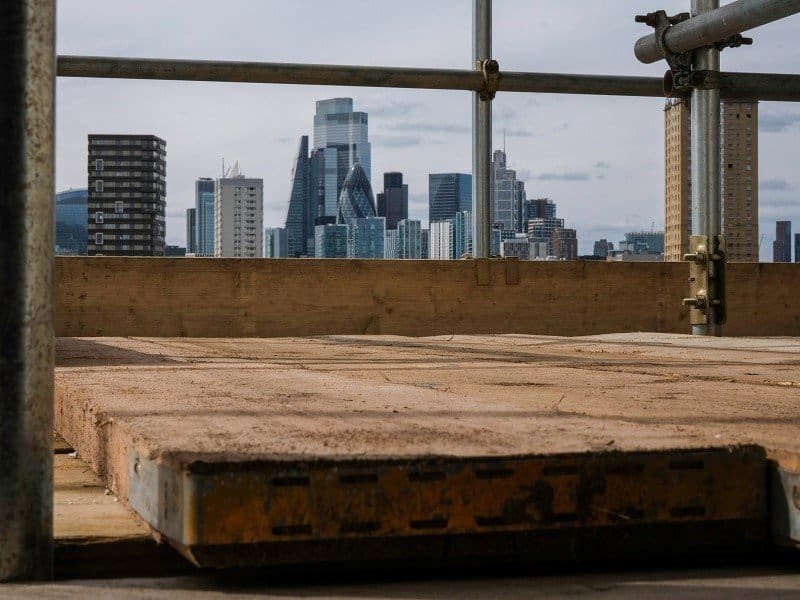
Different types of scaffolding have specific rules to keep construction sites safe. Supported scaffolds, like frame and pole scaffolds, need strong planks or decks for workers to stand on. They also need good support and anchorage to stay steady.
Suspended scaffolds, which hang from above, support workers and materials. They should have guardrails, midrails, and gear to prevent falls.
Aerial lifts used for high-up work must meet OSHA standards for construction and use. Workers must be trained and allowed to use aerial lifts safely.
Requirement 3: Training and Certification Requirements
Training and certification are important for construction workers who use scaffolding. Workers need to learn how to use scaffolds safely, which is essential for preventing accidents and injuries on the job.
Training covers setting up and removing scaffolds, spotting dangers, and using safety gear like harnesses. Certification serves as official proof that a worker has successfully completed the necessary training and is qualified to work with scaffolding. It assures employers and regulatory bodies that the worker can perform their duties safely.
Training should be conducted by experienced professionals who are knowledgeable about scaffolding safety standards and best practices, ensuring both theoretical and practical aspects are covered. Workers should practice setting up and dismantling scaffolds in a controlled environment before working on a real construction site. This helps them gain confidence and proficiency.
Safety training should not be a one-time event. Ongoing education and refresher courses are important to keep workers up-to-date with the latest safety standards and practices.

Requirement 4: Inspection and Maintenance Requirements
Checking and fixing scaffolding is important on construction sites. We need to look at it often to see if anything is broken or unsafe. Someone who knows about it should check it before work starts and after anything happens that might make it unsafe, like bad weather.
If anything is wrong, we need to fix it quickly. If any issues are identified during inspections, they need to be addressed immediately. This includes replacing broken parts or reinforcing weak areas to maintain the scaffold’s structural integrity. We also need to keep it clean and make sure everything moves properly.
By performing regular checks and promptly fixing any issues, construction workers can ensure that the scaffolding remains safe to use. This proactive approach helps prevent accidents and injuries, contributing to a safer job site for everyone involved.
Requirement 5: Fall Protection Measures Requirements
It’s super important to ensure construction workers don’t fall off scaffolding. To prevent this, we need to put up rails and barriers along the edges of the scaffold platforms.
Workers should also wear special gear, like harnesses and straps, to keep them from falling if they slip. They should wear this gear correctly and hook it onto strong points on the scaffold.
By doing these things, construction workers can ensure they don’t get hurt while working on scaffolding. Safety always comes first to ensure everyone stays safe on the job.
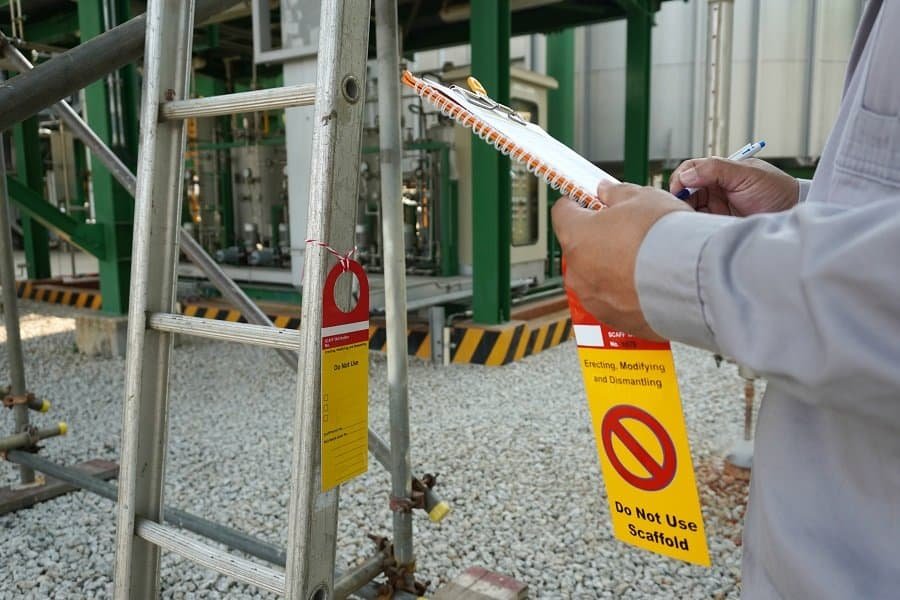
Requirement 6: Documentation and Record-Keeping Requirements
Absolutely, record-keeping is crucial in the construction industry, especially for maintaining safety standards. Scaffold inspections and worker training records are particularly vital aspects of this. Not only do these records help ensure compliance with regulations and standards, but they also serve as a documentation of due diligence in maintaining a safe work environment.
Recording scaffold inspections, including details like dates, inspectors’ names, and any issues found, provides a clear trail of accountability and helps in addressing safety concerns promptly. Similarly, maintaining comprehensive training records demonstrates that workers are adequately equipped with the knowledge and skills needed to operate safely on the job site.
Furthermore, these records serve as valuable references for future projects, enabling workers to learn from past experiences and continuously improve safety practices. Ultimately, prioritizing record-keeping contributes significantly to the overall safety culture within the construction industry, ensuring that everyone involved can work confidently and return home safely each day.
Requirement 7: Enforcement and Penalties Requirements
Enforcing safety rules is important on construction sites. If rules aren’t followed, there can be penalties, including fines or other consequences.
OSHA, the safety authority, checks construction sites to ensure rules are followed. If violations are found, citations and fines can be issued. These fines can be big, so following the rules is important.
Workers need to know the safety rules and follow them to avoid penalties. This means using scaffolds safely, wearing safety gear, and following other safety rules.
By following the rules, construction workers can keep themselves and others safe on the job site. It’s important to take safety seriously to avoid penalties and keep everyone safe.
Conclusion
Following OSHA rules for scaffolding is crucial for safety. It helps prevent accidents and injuries. Remember, scaffolds must be strong enough to hold weight. Workers need safe ways to get on and off them. Rails and toeboards stop falls. Inspect scaffolds often for problems.
Workers need training on scaffold safety and must be certified. Keep records of inspections and training. If rules aren’t followed, there can be fines. Safety is a top priority. Follow the rules to keep everyone safe on the job.




